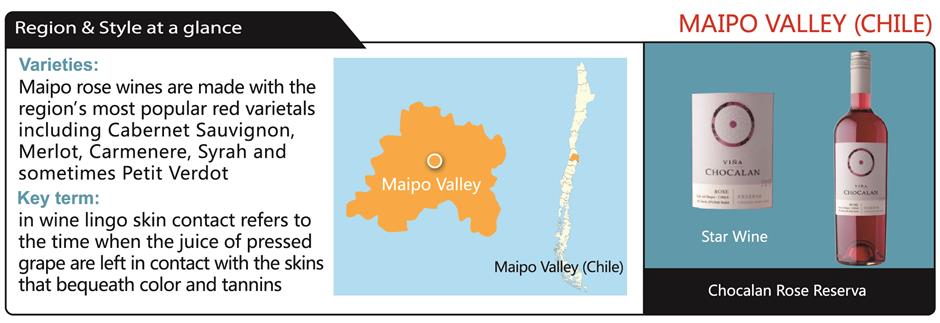Flexible and easy to read taro packs a pink punch

Elevated vineyards of Maipo Valley
The name Colocasia Esculenta probably doesn’t ring many bells with readers but the edible corms of this tropical plant are one of the world’s most important staple foods. We call them taro. Native to South or Southeast Asia, taro is believed to be one of mankind’s earliest cultivated plants. Today, Nigeria is by far the world’s largest producer of taro followed by China and a host of other Asian and African nations.
The humble taro packs an impressive nutritious punch with loads of magnesium and potassium minerals and three times the dietary fiber of a potato.
Taro, in its most basic form, goes well with practically all styles of wine. However, it’s when other ingredients are added that things get interesting. Today’s feature iDEAL story delves into the plethora of gourmet applications for taro thereby highlighting the extraordinary versatility of this remarkable food. In tune with this theme, I’ll explore one of the world’s most versatile styles of wine that just so happens to pair beautifully with most taro dishes.
Someday in the future, rose wines will truly take off in China. I don’t know when, but I’m sure it will happen. Most of the necessary dynamics already exist: specifically, a growing number of sophisticated drinkers looking for something new, fresh and Chinese food-friendly. Another foundation to my belief is the large number of independent and confident female wine lovers who demand wines they like, not the wines of their fathers, husbands or boyfriends. All of these factors portend a bright future for vino pink in China.
Some of the most passionate rose drinkers are in France where during the summertime rose wines vastly outsell their white counterparts. Likewise, in the UK, Spain, Italy and Germany, rose wines are always hot-off-the-shelf items combining quality drinking with affordable prices. In the world’s largest wine market, the USA rose wines are the preferred summertime drink of the young fashion-conscious, high-end consumers in New York City, San Francisco, Seattle, Los Angeles and Las Vegas. But to stereotype rose wines as exclusively summertime quenchers and refreshers would be a great disservice to the regal roses now being produced. The better examples of pink wines are meant to be enjoyed year-round.

The two largest producers of rose wines are France and Spain. The former makes some of the world’s most prized rose wines, particularly in Provence. Ancient Greeks started making wines in France about 600 BC and when the Romans arrived in 125 BC the rose wines of Provence were already famous throughout the empire.
The Provence-style tends to be fresh, subtle and nuanced with color ranging from pale peach to light pink. The wines often have a bracing acidity making them some of the freshest wines around and perfect companions to lighter fare, including salads and seafood preparations with taro. Recommended Provence rose producers include Domaine de Triennes, Chateau de Pibarnon, Chateau Paradis and Gabriel Meffre.
The adjacent large Southern French region of Languedoc also makes many fine rose wines that usually are appreciably less expensive than those of Provence. Like Provence, popular grapes used to make rose wines are Carignan, Cinsaut, Mourvedre and Syrah. Cabernet and Merlot are also popular varietals for Languedoc rose wines. Languedoc producers making high-quality affordable roses, include Chateau Gassier, Gerard Bertrand and Skalli. Chateau Mourgues du Gres in the Costieres de Nimes AOC region in Southern Rhone also has some can’t miss rose wines made by Francios Collard, the former winemaker of Chateau Lafite-Rothschild.
Spanish rose wines, or rosato as they are referred to in Spain, have a heavier and more robust style than French roses. Some of the best pink Spanish wines are made in Rioja, Ribera del Duero and Penedes. The former two regions are in the north of Spain where roses are made from the Tempranillo variety, while the equivalent wines of Penedes feature the Mediterranean varieties Grenacha, Mourvedre and Cinsault and international varieties like Cabernet Sauvignon, Merlot and Syrah. The heartier style makes them super companions to popular Chinese dishes like braised duck with taro and pork ribs with taro.
Some of my favorite Old World rose wines come from Italy, particularly Veneto and Puglia. Sangiovese, Corvina, Primitivo, Negroamaro and other Italian varieties make stylish pink wines replete with elegant red fruit and floral sensations. Some highly recommended Italian rose wines available in Shanghai include Core Negroamaro Rosato Salento IGT from Puglia and the sparkling La Tordera Cuvee di Gabry Rose Extra Dry IGT from Veneto.
Unlike Old World rose wines that are governed by historic and cultural influences, New World winemakers are free to make any style of rose they want. This results in a wide range of styles based on different varieties and personality of the winemaker. One region that’s producing an increasing number of reasonably priced fine rose wines is Maipo, Chile.
Long considered a red wine region, producers in Maipo have been quick to exploit the growing demand in developed wine markets for pink wines. One of my favorite New World roses is the Chocalan Rose Reserva from Maipo, Chile. The blend of Syrah with a fairly generous contribution of Petit Verdot makes for one of the most robust roses on the market that delightfully retains the vibrant freshness and aromatics we desire in rose wines. This is an ideal wine for a wide range of taro dishes featuring meats, seafood and vegetables.
Where to buy in Shanghai
Anteroom, 1222 Changle Rd, 6248-8985
Chocalan Maipo Valley Rose Reserva
Chateau Mourgues du Gres Fleur d’Eglantine Rose
Chateau Mourgues du Gres Galets Rose
Yishe Wines Shanghai, 16F-168 Zhengning Rd, 130-6200-3648
Core Negroamaro Rosato Salneto IGT
La Tordera Cuvee di Gabry Rose Extra Dry IGT















